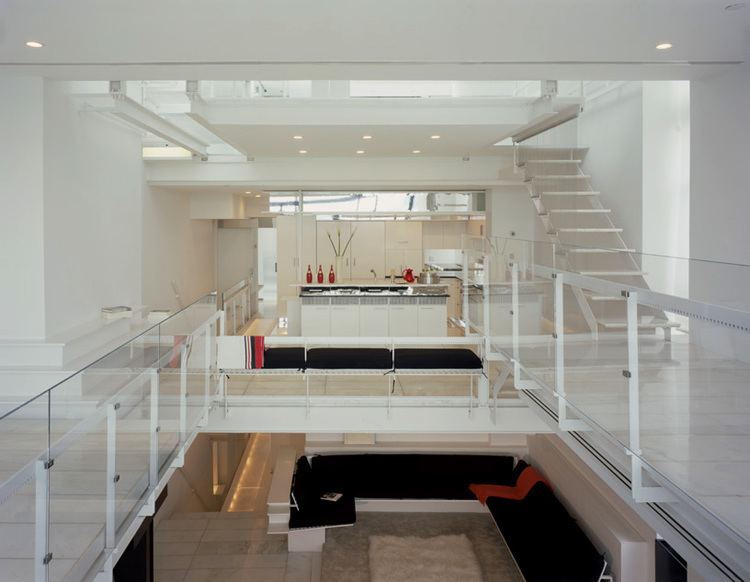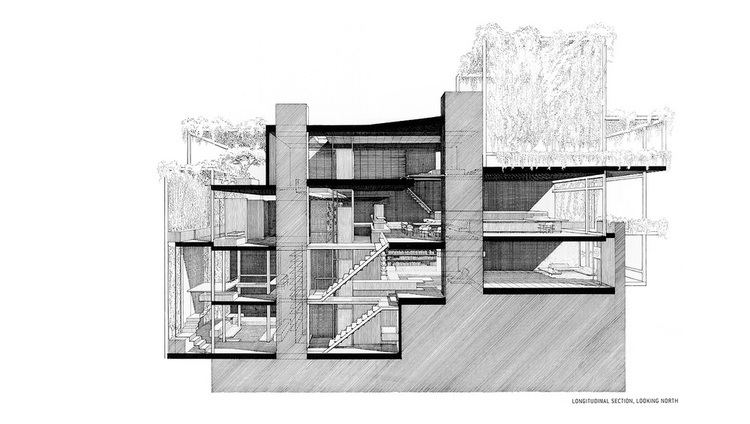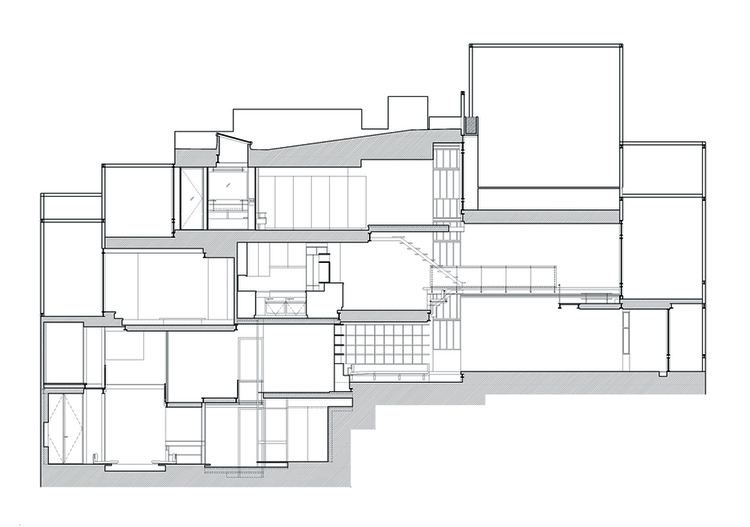 | ||
23 Beekman Place is an apartment building in the far east side of midtown Manhattan, in Turtle Bay. This building was created by Paul Rudolph, an American architect and once dean of Yale University. It is one of the last of his buildings still standing in New York City.
Contents

The architectural features of its four-level penthouse include a slender steel skeletal structure and a stepped succession of concrete panels cantilevering over an existing older brownstone, large walls of glass with panoramic East River views, high ceilings, and open floor plans. The facades come and appear from different time periods, but the cement on both of the facades blends the time periods.

Rudolph was commissioned for the project, even though the building ended up being his personal residency, in 1967 and began construction and continued to work on it until his death in 1997. Rudolph received negative feedback from the neighbors of 23 Beekman Place [mainly the neighboring buildings who did not want attention drawn to the area] but he was still cleared to design and build on top of the brownstone. The apartment continues to be renovated every few years as it changes hands from owner to owner with the price rising from one transaction to the next. The original construction was marked as finished in 1982 but underwent a big renovation which started in 2001 and was completed in 2006 upon the request of the first owners since Rudolph’s death, Gabriel and Michael Boyd. The Boyds “converted the four apartments and penthouse into a single-family residence.” Another significant renovation was ordered by an anonymous owner going under the title Ruppert LLC and was the more controversial of the renovations as it changed some of the materials and the essential and unique traits of the home.

History

23 Beekman Place is located between 50th and 51st Streets on the east side of the street. It is approximately 20 feet wide and is sectioned into 2 distinct parts: the five-story masonry structure and the addition of a four-story penthouse cantilevering over the front and back of the building. The two sections are very distinct from one another. The image is of a pristine tophat being placed on an old raggedy man. The styles of construction are not only different but invoke opposition to the extreme; a white and black building separating at the waist.

The building was originally opened in the 1860s and traded a number of hands, one being Beekman himself, before Rudolph was the owner. Paul Marvin Rudolph began his relationship with 23 Beekman Place in 1961 when he leased the fourth floor apartment. In 1965, he claimed the apartment at his permanent residence. About 10 years later, Rudolph bought 23 Beekman Place for $300,000 and began converting it into the five apartments including the multi-dimensional penthouse that it stands as now. Before 23 Beekman Place, Rudolph worked on the Erwin P. Staller Residence in 1973, located in Lloyd Harbor, New York.
Paul Rudolph completed only six buildings in New York City, and 23 Beekman Place was one of the most famous works which drew on concepts from a number of his other projects tackled during his career. His later work was based in Southeast Asia; it is said that 23 Beekman Place offers anticipating aspects of that work. Rudolph’s style was considered within the “‘second generation’” modernists. He trained at Harvard University in the 1940s studying under Walter Gropius (Bauhaus founder) but became unsatisfied by the International Style as he thought it was “‘monotonous’ and ‘timid’”. He understood modernism as the foundation of architecture, something meant to be built off. Similar to Rudolph’s respect for pre-existing styles, he respected the structure of the already standing brownstone at 23 Beekman Place and saw it as a structure “meant to be built off” which is exactly what he did.
He experimented with industrial materials and concrete was one that proved most essential, even though some of his greatest work didn’t use it as a primary material. The penthouse was made of steel which he would paint brown when exposed to “contrast with the color of the concrete panels". Rudolph saw his penthouse as a secret observation deck that he could escape to; “it served as his private laboratory in which the layered interior organization is expressed on the exterior through the play of open and closed forms that project out, rise up, and receded from the street”, according to one source. He played with the way a building looked on the inside as well as on the outside and the different perspectives it could be enjoyed from.
Construction
The first renovation to the original 23 Beekman Place was done by architect Franklin Abbott, who remodeled the front elevation and the interiors in 1929. Neo-classical details and round-arched windows were added to front exterior of the building. This was most likely when the service entrance was added with a metal canopy preventing water collection. The basement was also extended at the back of the property and the garden was surrounded by walls. After purchasing 23 Beekman Place, Rudolph had plans for a $120,000 renovation which the Department of Buildings rejected in July 1976.
There were problems with the height Rudolph planned to build up to and the expansion of the 2nd, 3rd, and 4th floors of 23 Beekman Place. The expansion was set at almost 25%. In February 1977, the Board of Standards and Appeals, after being presented with Rudolph’s case, but Alfonso Duarte approved the plans and the Department of Buildings granted a permit in June of that year. Donald Luckenbill, a Pratt Institute-trained architect, was the project architect from 1969 to 1982. Donald Luckenbill worked on the project from 1976 to 1977, meeting often with the plan examiners and he also worked closely with Marco Martelli, the contractor. Vincent J. DeSimone was the structural engineer.
The back of the building was destroyed, and the new facade, made of steel and glass, was installed. The addition of the rooftop was designed and constructed so as to be able to support a number of terraces and appendages of the sort. The projecting beam cantilevered nearly 5 feet over the sidewalk. Rudolph proposed there be a rooftop swimming pool, but the DOB rejected those ideas. The first orders of construction were the already standing brick walls, deemed unsafe. After that, Rudolph’s famous penthouse was constructed in 1977-78 out of very light steel and concrete block panels. Almost all of the interior work for the rentable apartments was finished by the end of 1978, and all the necessary materials for the penthouse were lifted to the fifth floor. By January 1982, a certificate of occupancy was assigned.
Real estate and landmarking
On November 16, 2010, the New York City Landmarks Preservation Commission voted to landmark 23 Beekman Place. Commission Chairman Robert B. Tierney said that “the landmarks that were designated today are a mosaic of architectural styles that span 150 years of New York City history, culture and growth" and that the “buildings speak volumes about our shared heritage, and help define who we are now."
In 2012, the house hit the market for $27.5 million when originally in 2002 Ruppert LLC had purchased the property for $6.325 million. The apartment is 4,100 square feet (381 m2), and As of April 2013, it was on the market for $22,500,000.
Ownership
In 1906, Maria L. Higgins owned the town house, before it was separated into apartments and sold it to Charles Schmid. One of these owners eliminated the stoop from the original structure and then divided the townhouse into two apartments where Schmid and his family and Roger Howson – later to be chief librarian at Columbia University – and his family lived in the 1910s. From 1922 until the 1950s, actress Katharine Cornell and her director-producer husband Guthrie McClintic lived at 23 Beekman Place, presumably having acquired it from Schmid.
The house was continually tweaked until his death in 1997, and then the property was then sold to Gabrielle and Michael Boyd in 2000. The Boyds converted the four apartments and one penthouse building into one residential home in 2001. Rupert LLC purchased the building in 2003, and by 2004, architects Andrew Bernheimer and Jared Della Valle were commissioned to renovate the apartment in what they believed would be a style similar to what Rudolph would have wanted. Della Valle and Bernheimer received awards for their work on the apartment and referred to the apartment as a “laboratory for its designer” in New York magazine in 2006. The renovations to the interior were controversial because some thought it should not have been altered. Some of the renovations, however, were practical, particularly the air-conditioning and the sprinkler system.
Interior
The building is made up of the ground story, the second story, the third, fourth, and fifth stories with a number of structural variances in style and material. The sixth story is where the penthouse begins and continues upwards for four more levels as the building ascends from one time period and abruptly switches to the next, once again like a modern top hat. The primary materials used were steel painted brown, metal beams, concrete panels, acrylic, and mylan. When renovating the apartment building a piece of sheetrock was found with the words “MELAMINE EVERYTHING” referring to the material used in the kitchen probably dating back to the original construction in the 1860s. The penthouse, “sometimes described as a quadriplex” was organized in four linked levels. The center of the Apartment was confined by the “cantilevered floors, narrow bridges, open stairs, windows of varying dimensions, and terraces” amounting to an estimation of seventeen separate levels.
William Grindereng, once a tenant there, describes Rudolph's residence as follows:
"...his apartment at Beekman Place in New York underwent a number of reincarnations. One of them, I think it was the second one to the last, featured a bird walk, like [Frank Lloyd] Wright’s at Taliesin. It was a very narrow little gangway that went out to a little seating area with seats on two sides. It was supported on some very, very tall steel columns underneath this little seating area. The ground sloped away precipitously to Roosevelt Boulevard and the East River. The frightening thing about it was this thing was constructed all of metal grating. When you went out there, you could look down and see through. It was very unsubstantial. Rudolph loaned me that apartment once when he was out of town and I was doing something in New York. I stayed there. I went out on this bird walk to the little seating area and it was really scary. I mentioned this to Rudolph when he came back. He said, 'Yes, I’m afraid to go out there myself.'"
The lucite bathtub hanging above the kitchen is a very popular aspect of 23 Beekman Place, as the base of the tub is translucent, a very provocative aspect for a New York City home.
The stairs have no railings and used to scare Rudolph’s cleaning lady. When the Boyds came into ownership they added white-frosted-acrylic railings to the stairs and sheetrock to cover the skylight of a bathtub over the kitchen.
